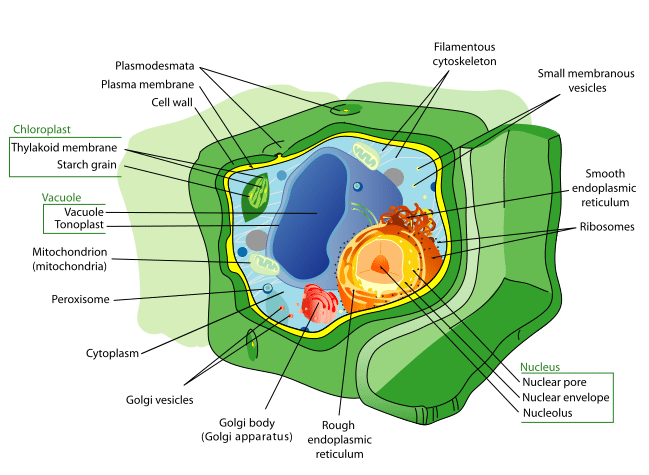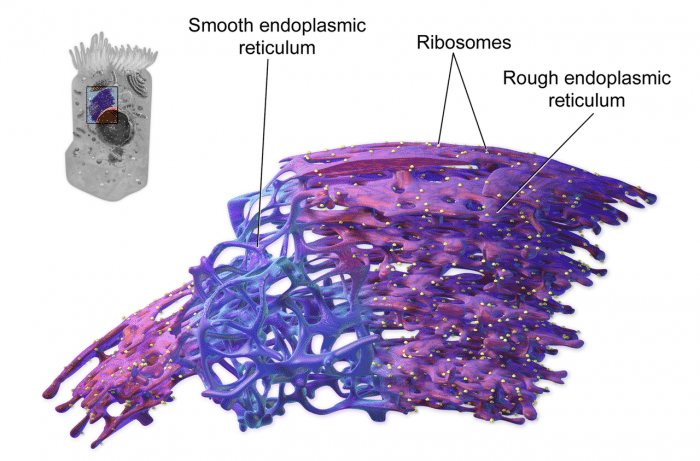
Plant cells contain many organelles such as ribosomes, the nucleus, the plasma membrane, the cell wall, mitochondria, and chloroplasts. In addition, plant cells differ from animal cells in a number of key ways. Examining a diagram of the plant cell will help make the differences clearer. Let’s go over the individual components of plant cells listed on a diagram such as the one above, and explore the roles that each of the organelles has. This will give us some insight into how plant cells differ from animal cells.
The parts of a plant cell include the cell wall, the cell membrane, the cytoskeleton or cytoplasm, the nucleus, the Golgi body, the mitochondria, the peroxisome’s, the vacuoles, ribosomes, and the endoplasmic reticulum.
Parts Of A Plant Cell
The Cell Wall
Let’s start from the outside and work our way inwards. To start with, the entire cell is enveloped by a rigid structure called the cell wall. The cell wall’s function is to give protection to the cell and to support it. The cell wall must be both permeable yet rigid. It must be permeable so that materials can move in and out of the cell, but rigid enough that it supports and protects the cell. Cell walls are composed out of carbohydrate polymers referred to as cellulose. Cell walls are not present in the cells of animals, but they are found in algae and fungus, in addition to plant cells. During cellular division, plant cells grow a new cell wall down the middle, separating one cell into two. This is different from how animal cells separate, as they become two cells by being pinched in half, a process called cytokinesis.
Cell Membrane
Located just inside the cell wall is the cell membrane or plasma membrane. The function of the plasma membrane is to keep the cytoplasm and the rest of its contents, like nutrients and organelles, separated from the outside environment. The plasma membrane is semi-permeable much like a cell wall. The plasma membrane provides an additional layer of protection to the materials inside the cell, in addition to keeping desired substances bound within. The cell membrane also plays a role in regulating the balance and growth of the cell overall.
Cytoplasm
Inside both the cell membrane and the cell wall is the cytoplasm, a jellylike substance that makes up the vast majority of the cell’s interior. The materials necessary for the cell’s survival such as enzymes, nutrients, salt, and water are found here, as are the various organelles belonging to the cell. A matrix of fibers can be found within the cytoplasm, a structure referred to as the cytoskeleton, the function of which is to help the cell maintain its shape.
Nucleus

Photo: By Mariana Ruiz LadyofHats – I did it myself with adobe ilustrator using the information found here [1], [2] ,[3], [4] and [5], Public Domain, https://commons.wikimedia.org/w/index.php?curid=736389
Endoplasmic Reticulum

Photo: A 3D rendering of the endoplasmic reticulum. Photo: Blausen.com staff (2014). “Medical gallery of Blausen Medical 2014”. WikiJournal of Medicine 1 (2). DOI:10.15347/wjm/2014.010. ISSN 2002-4436. – Own work, CC BY 3.0
The endoplasmic reticulum is an organelle responsible for the creation of lipids. In addition synthesizing lipids, the endoplasmic reticulum transports lipids around to different parts of the cell. The endoplasmic reticulum is important for eukaryotic cells, as without it the lipids that make up the various membranes of the cell cannot be produced. The endoplasmic reticulum consists of two halves, the smooth endoplasmic reticulum and the rough endoplasmic reticulum. The rough endoplasmic reticulum gets its name from the fact that it is covered in ribosomes, which as previously mentioned are synthesized in the nucleolus. The smooth endoplasmic reticulum lacks ribosomes.
The Golgi Apparatus
The Golgi Apparatus, sometimes referred to as the Golgi body, is often said to be the “post office” of the cell, owing to the fact that it packages and ships various compounds to the parts of the cell where they are needed. The Golgi body ships lipids and proteins to other organelles. Many of the products synthesized by the endoplasmic reticulum make their way to the Golgi Apparatus, being carried along by vesicles. Molecules will travel through the Golgi Apparatus, being modified as they do so, and once these molecules reach the surface of the Golgi Apparatus they are put into vesicles and sent out to the respective destinations.
Chloroplasts

Photo: Photo: By Kelvinsong – Own work, CC BY 3.0, https://commons.wikimedia.org/w/index.php?curid=26247252
Chloroplasts are the organelles responsible for photosynthesis in plant cells. They are the structures that allow plants to absorb the ion-based energy from the sun and converted into usable energy by combining it with carbon dioxide and water. Chloroplasts have pigments and plastids within them. Pigments are the structures that absorb the electromagnetic radiation coming from the sun, while plastids are responsible for storing the energy that the pigments absorb. While chlorophyll is the most common type of pigment for plants, giving them their green color, other pigments such as phycolobins and carotenoids exist.
Mitochondria
Mitochondria are often said to be the powerhouse of the cell, because they are the organelle responsible for generating energy. Both animal cells and plant cells have mitochondria, unlike animals how animal cells lack chloroplasts. The mitochondria within cells create a substance known as ATP through a process called cellular respiration, storing the energy that is absorbed from the sun (or in the case of animal cells by consuming other organisms) in a form of the organism can use. Plants accomplish this by converting carbon dioxide and water into energy, catalyzed by the sunlight they are exposed to.
Peroxisomes
Peroxisomes are involved in the process of photorespiration. Photorespiration is the method by which plant cells respirate, taking up light and producing energy. Photorespiration what happens in plants when carbon dioxide levels are too low to produce energy through photosynthesis. The process is somewhat wasteful compared to regular photosynthesis. Peroxisomes also play a role in the creation of carbohydrates from fatty acids, which allows the plant to determine it seems. Peroxisomes are also responsible for creating water out of hydrogen peroxide, which must be broken down otherwise it will be toxic to the cell.
Ribosomes
Ribosomes can be found either attached to the endoplasmic reticulum or free-floating in the cell cytoplasm, and they are responsible for synthesizing proteins. The ribosomes are created in the nucleolus of the cell. Ribosomes are made out of two smaller subunits, a large ribosomes subunit and a small ribosomal subunits. The transfer RNA or tRNA encodes the correct series of genetic instructions into the mRNA or messenger RNA, which is what ensures that the right proteins are created. Functional proteins begin as amino acids, linked together into polypeptide chains by the ribosomes.
Vacuoles
The vacuoles play many different roles within a cell. Within plant cells, and animal cells as well, they assist in the detoxification, protection, transportation, and growth processes of cells. However, there are some differences between the vacuoles found in animal cells in the vacuoles found in plant cells. Plant cells usually have a single large vacuole which can account for the vast majority of the cell’s volume, whereas animal cells can have many more vacuoles which are also smaller. Vacuoles exert pressure on the cell wall of the plant cell, and in doing so they help maintain the cell’s turgor pressure. The cell’s vacuoles are also responsible for the nullification and breakdown of toxic substances such as heavy metals and poisons found within the cytosol of the cell, so they help protect the cell.
The Process Of Photosynthesis
The process of photosynthesis makes use of the chloroplasts and the chlorophyll within, which are mentioned above. Chlorophyll is a pigment, and it is capable of absorbing certain parts of the light spectrum. Photosynthesis also needs several key ingredients in order to be carried out: carbon dioxide and water.
Organisms capable of photosynthesis have organelles referred to as plastids floating around within the cytoplasm of the cell. The difference between plastids and pigments is that plastids contain the pigment as well as other structures like starches and fats. The chloroplast is the plastid, while the chlorophyll is the pigment. Chloroplasts have their own genes within them, much like mitochondria in animal cells, and they are what convert solar energy into carbohydrates.
Chlorophyll function by absorbing the red and blue wavelengths of light, and they can be divided into two different classes. Bacterial chlorophyll are a type of chlorophyll found only within bacteria, while regular chlorophyll is found within photosynthesizing algae and plants. After the chlorophyll absorbs the sunlight, it uses the energy from the vibrating electrons in the sunlight to start a process that will convert carbon dioxide and water into a form of usable energy known as ATP. This occurs as the ions flow through the pipeline known as ATP synthase and move from the thylakoid into the stroma.
How Animal Cells And Plant Cells Differ
While plant and animal cells are similar in many ways, such as possessing the same core structures (like a nucleus, mitochondria, a Golgi body, and a cell membrane), they are also different in notable ways.
- To begin with, animal cells are typically substantially smaller than plant cells, with plant cells ranging from 10 to 100 µm in length, whereas animal cells are typically between 10 to 30 µm in length.
- The way the cells store energy is also different. Starch is the way plant cell store energy, whereas animal cells store their energy as glycogen.
- Animal cells lack a cell wall, while plant cells have a cell wall.
- The process of cellular division and replication is also different in plant cells and animal cells. In animal cells, cytokinesis creates two new cells by pinching a single cell in half until there are two of. In contrast, plant cells divide simply by creating a new cell wall down the middle of the cell.
- As previously mentioned, animal cells have many small vacuoles within them, whereas plant cells typically only have a single large vacuum.
- Plant cells rarely have lysosomes within them, because the vacuole of a plant cell breaks down molecules, whereas animal cells need lysosomes to digest cellular macromolecules.
- Finally, plant cells have chloroplasts while animal cells lack chloroplasts.









